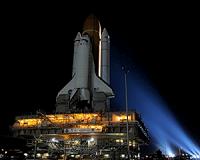 |
Washington DC (SPX) Apr 07, 2011 By elevating its life and physical sciences research program, NASA could achieve the biological understanding and technical breakthroughs needed to allow humans to be sent deeper into space, including to Mars, says a new National Research Council report. In addition, access to the space environment - for example, on the International Space Station - will open up further opportunities for groundbreaking research in the physical and life sciences. The report, one of a series of decadal surveys that the Research Council has completed for NASA and the first on interdisciplinary life and physical sciences for exploration missions, lays out a research agenda for the next decade that could bring about developments with substantial payoffs for human exploration of space. Several years of budgetary challenges and priority being given to other programs at NASA have left the life and physical sciences program dramatically reduced in both scale and scope, with no clear institutional home at the space agency, according to the committee that wrote the report. As a result NASA is now poorly positioned to take full advantage of the laboratory environment offered by the International Space Station. Strong leadership with sufficient scientific gravitas is necessary to ensure that the life and physical sciences program has a voice at the table during deliberations about NASA priorities and resources and to highlight the central role that the life and physical sciences play in human exploration missions, the report says. It concludes that re-establishing the program under a single management structure housed in an appropriate part of the agency will be key to the program's success. In addition, a stable and adequate funding base is required to support a robust research program that attracts top scientists. "A focused life and physical sciences program can make possible the achievements that bring the space community, policymakers, and the U.S. public to a realization that we are ready for the next significant phase of human space exploration," said the committee co-chair, Elizabeth Cantwell, director of mission development, Lawrence Livermore National Laboratory, Livermore, Calif. For example, effective countermeasures are needed to offset the adverse effects of the space environment on the health and performance capabilities of astronauts on prolonged missions along with a deeper understanding of how gravity affects the human body. This type of information will be essential to realize extended space voyages like Mars missions or a potential base on the moon. In addition, astronauts on long missions would require the ability to collect or produce large amounts of water. Research in the physical and life sciences that yields game-changing discoveries like regenerative power sources would also help make deep space travel feasible. According to the report, research to allow extended human space exploration will also offer terrestrial benefits. "Research in the life and physical sciences can enable space missions and, as a unique benefit, there is critical research that can in turn be enabled on Earth by access to space," said Wendy Kohrt, professor at the University of Colorado, Denver, and co-chair of the committee. "With the advantage of the space environment, we believe there is an opportunity to significantly advance fundamental scientific understanding."
Share This Article With Planet Earth
Related Links National Academies Space Tourism, Space Transport and Space Exploration News
 Witnesses Say Future Of NASA Human Space Flight Is Uncertain
Witnesses Say Future Of NASA Human Space Flight Is UncertainWashington DC (SPX) Apr 01, 2011 today, in a hearing of the Subcommittee on Space and Aeronautics, witnesses expressed serious concern about the lack of clear focus by the Administration on NASA's transition from the Space Shuttle program toward development of the Space Launch System (SLS) and Multi Purpose Crew Vehicle (MPCV). These vital components of NASA's human space flight program were outlined as top priorities in the NA ... read more |
|
| The content herein, unless otherwise known to be public domain, are Copyright 1995-2010 - SpaceDaily. AFP and UPI Wire Stories are copyright Agence France-Presse and United Press International. ESA Portal Reports are copyright European Space Agency. All NASA sourced material is public domain. Additional copyrights may apply in whole or part to other bona fide parties. Advertising does not imply endorsement,agreement or approval of any opinions, statements or information provided by SpaceDaily on any Web page published or hosted by SpaceDaily. Privacy Statement |